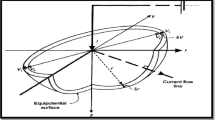Abstract
In the analysis of resistivity tomography data, boreholes are assumed to be drilled vertically and have no borehole deviation with depth. However, such a condition is seldom encountered in real field situations. Moreover, in two-dimensional (2-D) tomographic imaging, it is assumed that the boreholes belong to the section to be imaged, while this is often far from the case in real situations. Given these discrepancies between assumptions and reality, unrealistic subsurface images may be obtained due to the improper handling of borehole deviation. In this study, the borehole deviation effect in 2-D resistivity tomography is analyzed. The effect is analyzed using a 3-D finite element forward modeling program to handle a general case of 3-D borehole deviations. As a further step, the borehole deviation has been included in the inversion process, which is implemented by assuming that the subsurface structure is 2-D within a 3-D resistivity tomography inversion code. By inverting the resistivity data obtained from a site where boreholes are significantly deviated, it is shown that the borehole deviation should be taken into account to obtain accurate subsurface images. The enhancement was also demonstrated with the 3-D ERT imaging of field data set.
Similar content being viewed by others
References
LaBrecque, D.J., Morelli, G., Daily, W., Ramirez, A., and Lundegard, P., 1999, Occam’s inversion of 3-D electrical resistivity tomography. In: Oristaglio, M. and Spies, B. (eds.), Three-dimensional Electromagnetics. The Society of Exploration Geophysicists, p. 575–590.
Morelli, G. and La Brecque, D.J., 1996, Advances in ERT inverse modeling. European Journal of Environmental and Engineering Geophysics, 1, 171–186.
Oldenborger, G.A., Routh, P.S., and Knoll, M.D., 2005, Sensitivity of electrical resistivity tomography data to electrode position errors. Geophysical Journal International, 163, 1–9.
Sasaki, Y., 1992, Resolution of resistivity tomography inferred from numerical simulation. Geophysical Prospecting, 40, 453–463.
Yi, M.-J., Kim, J.-H., and Chung, S.-H., 2003, Enhancing the Resolving power of Least-squares inversion with Active Constraint Balancing. Geophysics, 68, 931–941.
Yi, M.-J., Kim, J.-H., and Son, Y., 2006, Application of 3-D resistivity tomography to delineate subsurface structures. Exploration Geophysics, 37, 268–277.
Author information
Authors and Affiliations
Corresponding author
Rights and permissions
About this article
Cite this article
Yi, MJ., Kim, JH. & Son, JS. Borehole deviation effect in electrical resistivity tomography. Geosci J 13, 87–102 (2009). https://doi.org/10.1007/s12303-009-0008-2
Received:
Accepted:
Published:
Issue Date:
DOI: https://doi.org/10.1007/s12303-009-0008-2




